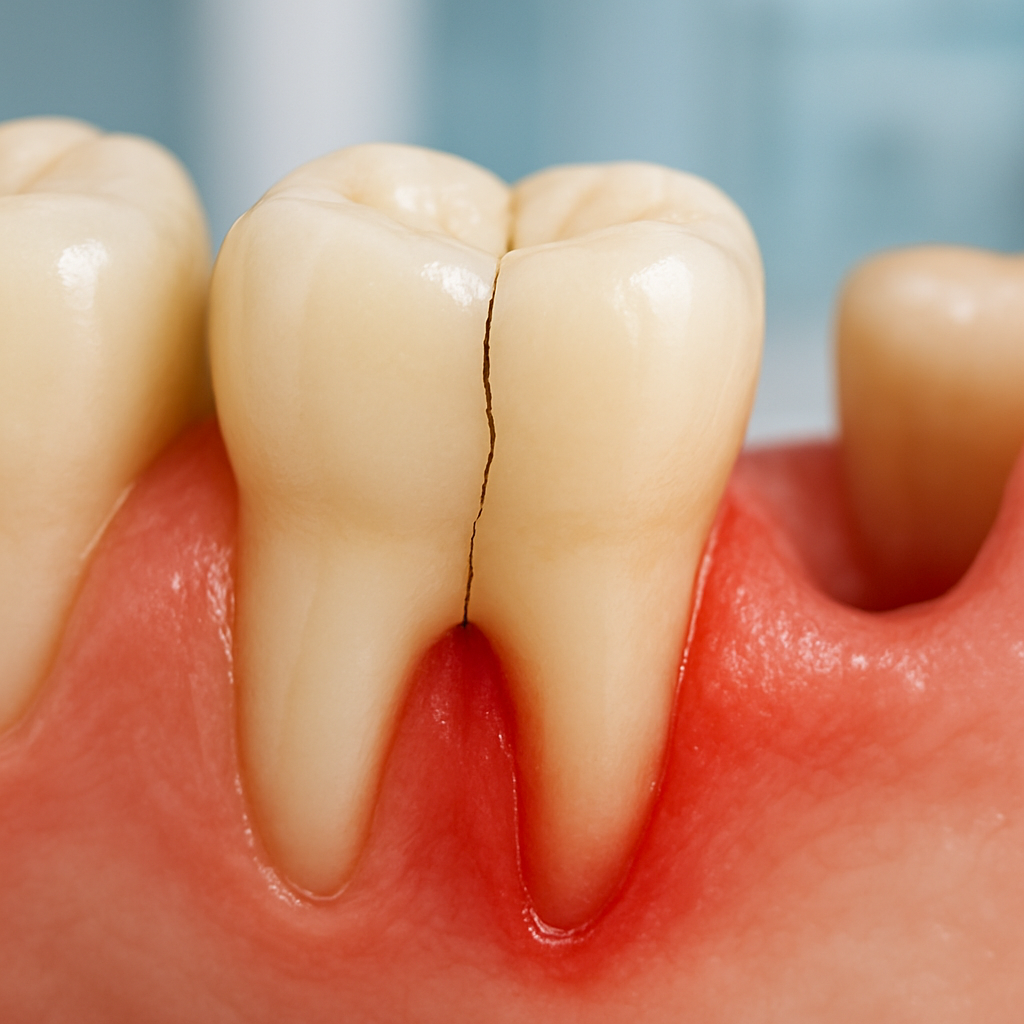Have you ever felt a sharp, fleeting pain in your tooth while chewing but found nothing wrong on the surface? You may be experiencing what dental experts call, these are invisible tooth cracks, a tiny, nearly invisible crack that can have serious consequences if left untreated. Unlike cavities or visible damage, these microcracks often go unnoticed until pain becomes persistent, or worse, the tooth breaks.
Often categorized under cracked tooth syndrome, these subtle fractures can develop due to repetitive stress, aging, or chronic habits like teeth grinding. Understanding these hidden threats is essential for preventing long term complications, including root damage and tooth loss.
What Are Silent Tooth Fractures? Understanding the Hidden Cracks in Your Teeth
Silent tooth fractures are hairline cracks in the enamel or dentin that don’t initially show obvious signs. Because they don’t always appear on dental X-rays, they can be tricky to detect without advanced imaging or magnification tools. Over time, however, they can deepen and lead to nerve exposure, infection, or even full tooth fracture.
Molars are most susceptible due to their role in grinding and chewing. Many cases develop silently in individuals who don’t even realize they’re damaging their teeth daily by clenching their jaw under stress, chewing ice, or biting their nails. If untreated, these seemingly minor cracks can become a gateway for bacteria, leading to inflammation of the dental pulp and long-term oral health problems.
Common Signs of Microcracks and Occasional Tooth Pain

Why You May Feel Pain When Biting Down with No Visible Cavity?
The most common symptom is sharp pain when biting or releasing pressure, especially while eating hard or chewy foods. You might feel like the pain comes and goes unpredictably, which often delays people from seeking dental care. This kind of discomfort occurs because the crack flexes under pressure, momentarily irritating the inner pulp and nerves.
Tooth Sensitivity to Cold or Sweet: A Subtle Red Flag
You might also experience sensitivity to temperature changes or sugary foods. The reason is that the crack allows stimuli to penetrate the enamel layer and irritate the dentin or pulp. Over time, this sensitivity may become more frequent, even without any visible tooth decay, indicating that a silent fracture may be worsening beneath the surface.
Causes Behind Hairline Tooth Cracks: Everyday Habits That Harm
How Teeth Grinding and Clenching (Bruxism) Lead to Enamel Damage?
One of the leading causes of invisible tooth cracks is bruxism, the habitual grinding or clenching of teeth, often during sleep or times of stress. This condition puts immense pressure on the molars and can slowly lead to enamel fatigue, microfractures, and pain. Many people are unaware they suffer from bruxism until symptoms like jaw pain, headaches, or cracked teeth emerge.
The Impact of Age, Fillings, and Biting Hard Objects
Several common factors contribute to the development of these cracks.
The Impact of Age
As we age, our teeth naturally undergo wear and tear. Years of chewing, grinding, and exposure to temperature changes can cause enamel to weaken, making it more susceptible to fine cracks. Older adults are more likely to develop hairline fractures due to this long-term stress on their teeth.
Fillings and Dental Work
Large or old fillings can weaken the surrounding tooth structure. When a filling is too big or the tooth has undergone repeated dental procedures, the enamel can lose its natural strength. This makes the tooth more prone to cracking, especially under pressure or stress.
Biting Hard Objects
Chewing on hard items such as ice, hard candy, or unpopped popcorn kernels can put intense pressure on teeth. This force may exceed the enamel’s limit, resulting in tiny fractures. Even habits like using your teeth to open packages can cause cracks to form over time.
Diagnosing Silent Tooth Fractures: Why They’re Often Missed
Limitations of Traditional X-Rays in Detecting Tooth Microcracks
Cracks that run vertically or are extremely fine may not show up on standard dental radiographs. This makes early diagnosis challenging, especially when the tooth appears healthy from the outside. Many cases are misdiagnosed as general sensitivity or dismissed as stress-related discomfort.
Role of Dental Microscope and CBCT Imaging in Diagnosis
To get a clearer picture, many dentists now use dental microscopes, fiber optic transillumination, or cone beam computed tomography (CBCT). These tools allow for high-detail imaging and better visibility of subtle fractures. Early detection is critical, as prompt treatment can prevent escalation to more invasive procedures like root canals or extractions.
Risks of Ignoring Cracked Tooth Syndrome

How Small Cracks Can Lead to Root Infections and Tooth Loss?
Left untreated, a silent crack can extend deep into the tooth’s root. This provides a path for bacteria to invade the pulp chamber, leading to pulpitis (nerve inflammation), abscess formation, and, ultimately, loss of the tooth. The earlier these microcracks are addressed, the higher the chances of saving the tooth.
When a Root Canal or Tooth Extraction Becomes Necessary
Once the inner pulp becomes infected or necrotic, root canal therapy may be required to clean out the infection and seal the tooth. In some cases, if the crack has reached below the gum line or split the tooth entirely, extraction followed by an implant or bridge may be the only solution.
Treatment Options for Hairline Tooth Cracks
Bonding, Crowns, and Root Canal Therapy: What is Right for You?
When it comes to restoring damaged or decayed teeth, your dentist may recommend bonding, crowns, or root canal therapy. Each treatment serves a specific purpose, and choosing the right one depends on the condition of your tooth.
Dental Bonding
Bonding is a procedure where a tooth-colored resin is applied to the tooth surface to repair minor chips, cracks, or cavities. It’s a non invasive and cost effective solution, typically completed in one visit. Bonding is best for small cosmetic improvements or minor damage that does not affect the tooth’s structure.
Dental Crowns
Crowns are custom-made caps that cover the entire tooth. They are used when a tooth is significantly decayed, cracked, or weakened. A crown restores the tooth’s shape, size, and strength, and can be made from porcelain, metal, or ceramic. This treatment usually requires two visits and offers long-term protection for compromised teeth.
Root Canal Therapy
Root canal therapy is necessary when the pulp inside the tooth becomes infected or inflamed due to deep decay or injury. During the procedure, the infected pulp is removed, the inside of the tooth is cleaned, and it is then sealed. Often, a crown is placed afterward to protect the treated tooth. This therapy preserves the natural tooth and prevents the need for extraction.
Scientific Researches and Treatment Outcomes
Recent studies have shed light on the prognosis and treatment efficacy for cracked teeth:
- “The treatment outcomes of cracked teeth: A systematic review and meta-analysis“ by Zhang et al. (2024) reported a tooth survival rate of 92.8–97.8% over 1–6 years for cracked teeth with vital pulp managed conservatively. However, direct restorations without cuspal coverage increased the risk of pulpal complications and tooth extraction compared to full-crown restorations.
- “Outcome and Survival of Endodontically Treated Cracked Posterior Permanent Teeth: A Systematic Review and Meta-analysis“ by Leong et al. (2020) found that root canal treatment (RCT) in cracked posterior teeth resulted in a survival rate of 88% and a success rate of 82% after one year. The presence of periodontal pockets associated with cracks increased the risk of tooth loss.
- “Occlusal veneer restoration treatment outcomes of cracked tooth syndrome: A 22.4-month follow-up study“ by Li et al. (2024) showed a 12-month pulp survival rate of 92.6% and a tooth survival rate of 100%, indicating that such restorations can be effective when cracks involve only enamel and dentin.

How to Prevent Silent Tooth Fractures and Maintain Strong Oral Health?
Silent tooth fractures are small cracks in the teeth that often go unnoticed until they cause pain or lead to more serious dental issues. Preventing these hidden fractures is essential to maintaining long-term oral health.
Avoid Hard Foods and Chewing Habits
Chewing on hard objects like ice, pens, or hard candies can cause micro-cracks in your teeth. Over time, these can develop into fractures. Avoid biting down on hard substances and never use your teeth as tools to open packages.
Use a Mouthguard
If you grind your teeth at night (bruxism) or play contact sports, wearing a custom fitted mouthguard can protect your teeth from excessive pressure and impact. This reduces the risk of fractures caused by clenching or sudden blows.
Maintain Good Oral Hygiene
Brushing twice a day with fluoride toothpaste, flossing daily, and visiting your dentist regularly can help detect early signs of damage. Healthy teeth are more resistant to fractures, so keeping your enamel strong is crucial.
Don’t Ignore Tooth Pain
Even minor or occasional tooth pain can be a sign of a hidden fracture. If you experience sensitivity while chewing or to hot and cold foods, seek a dental evaluation promptly.
Avoid Sudden Temperature Changes
Exposing your teeth to extreme temperature changes like eating something hot followed by something cold can weaken enamel and lead to cracking over time. Try to avoid this whenever possible.
Regular Dental Checkups
Routine dental visits are key in identifying silent fractures early. Dentists can spot hairline cracks using advanced imaging and take action before the condition worsens.
Frequently Asked Questions
Q: Can a cracked tooth heal on its own?
No. Tooth enamel does not regenerate. While symptoms might temporarily subside, the crack will remain and potentially worsen without treatment.
Q: How do I know if my tooth pain is from a crack?
Pain when chewing or releasing pressure, along with sensitivity to cold or sweet foods and no visible cavity, is a common pattern seen in cracked tooth syndrome.
Q: Will a cracked tooth always need a crown or root canal?
Not always. Treatment depends on the depth and severity of the crack. Minor surface cracks may only need bonding, while deeper cracks might require a crown or root canal.
Q: Is it safe to wait and watch a cracked tooth?
Delaying treatment increases the risk of the crack spreading to the root, where it becomes more difficult and expensive to treat. Early intervention is highly recommended.

 Medically reviewed by
Medically reviewed by